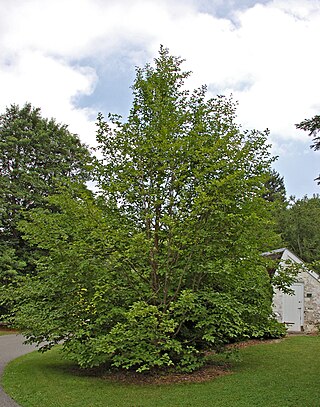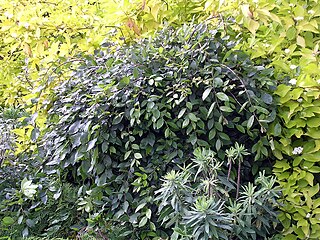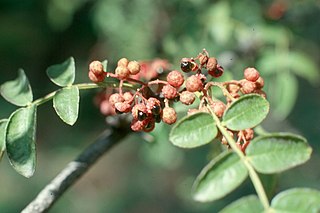
Magnolia grandiflora, commonly known as the southern magnolia or bull bay, is a tree of the family Magnoliaceae native to the Southeastern United States, from Virginia to central Florida, and west to East Texas. Reaching 27.5 m (90 ft) in height, it is a large, striking evergreen tree, with large, dark-green leaves up to 20 cm long and 12 cm wide, and large, white, fragrant flowers up to 30 cm (12 in) in diameter.

Yucca filamentosa, Adam's needle and thread, is a species of flowering plant in the family Asparagaceae native to the southeastern United States. Growing to 3 metres tall, it is an evergreen shrub valued in horticulture.

Xanthorhiza simplicissima (yellowroot) is the only member of the genus Xanthorhiza, and one of very few genera in the family Ranunculaceae with a woody stem. It is native to the eastern United States from Maine south to northern Florida and west to Ohio and eastern Texas. It contains the alkaloid berberine, which has a number of traditional and contemporary uses for dyeing and medicine.

Hydrangea arborescens, commonly known as smooth hydrangea, wild hydrangea, sevenbark, or in some cases, sheep flower, is a species of flowering plant in the family Hydrangeaceae. It is a small- to medium-sized, multi-stemmed, deciduous shrub up to 2 m (7 ft) tall that is native to the eastern United States.

Hydrangea cinerea, the ashy hydrangea or gray hydrangea, is a small to medium sized, deciduous shrub up to 3 m tall; its natural range is interior regions of the southeastern United States. Its common names reflect the ashy or gray appearance of the undersides of its leaves, which results from a dense pubescence.

Stewartia pseudocamellia, also known as Korean stewartia, Japanese stewartia, or deciduous camellia, is a species of flowering plant in the family Theaceae, native to Japan and Korea.
Allan M. Armitage is professor of horticulture at the University of Georgia, US, where he teaches, conducts research, and runs the University of Georgia Horticulture Gardens—producing annual guidelines for annuals and perennials suitable for heat and humidity.

The winged elm cultivar Ulmus alata 'Lace Parasol' was found by a North Carolina nurseryman growing in local woods. Removed to his yard, it remained there until his death, when it was removed again to the North Carolina State Arboretum in Raleigh by J. C. Raulston.

Stewartia malacodendron, the silky camellia, silky stewartia or Virginia stewartia, is a species of flowering plant in the family Theaceae. It grows slowly into a large deciduous shrub or small tree, typically 3–4.5 m (10–15 ft) tall, but sometimes as tall as 9 m (30 ft). It is native to the southeastern United States.

Buddleja crispa, the Himalayan butterfly bush, is a deciduous shrub native to Afghanistan, Bhutan, North India, Nepal, Pakistan and China, where it grows on dry river beds, slopes with boulders, exposed cliffs, and in thickets, at elevations of 1400–4300 m. Named by Bentham in 1835, B. crispa was introduced to cultivation in 1850, and came to be considered one of the more attractive species within the genus; it ranked 8th out of 57 species and cultivars in a public poll organized by the Center for Applied Nursery Research (CANR) at the University of Georgia, US. In the UK, B. crispa was accorded the Royal Horticultural Society's Award of Merit in 1961. However, the species is not entirely cold-hardy, and thus its popularity is not as ubiquitous as it might otherwise be.

Prunus tomentosa is a species of Prunus native to northern and western China, Korea, Mongolia, and possibly northern India. Common names for Prunus tomentosa include Nanjing cherry, Korean cherry, Manchu cherry, downy cherry, Shanghai cherry, Ando cherry, mountain cherry, Chinese bush cherry, and Chinese dwarf cherry.

Forsythia × intermedia, or border forsythia, is an ornamental deciduous shrub of garden origin.

Zanthoxylum americanum, the common prickly-ash, common pricklyash, common prickly ash or northern prickly-ash, is an aromatic shrub or small tree native to central and eastern portions of the United States and Canada. It is the northernmost New World species in the citrus family, Rutaceae, and is the type species in its genus, which includes sichuan pepper. It can grow to 10 meters (33 ft) tall with a diameter at breast height (DBH) of 15 cm (5.9 in). It produces membranous leaflets and axillary flower clusters. The wood is not commercially valuable, but oil extracts from the bark have been used in traditional and alternative medicine, and have been studied for antifungal and cytotoxic properties. The genus name is sometimes spelled Xanthoxylum.

Hydrangea paniculata, or panicled hydrangea, is a species of flowering plant in the family Hydrangeaceae native to southern and eastern China, Korea, Japan and Russia (Sakhalin). It was first formally described by Philipp Franz von Siebold in 1829.

Lonicera nitida is a species of flowering plant in the honeysuckle family. In English, it is sometimes given the common names box honeysuckle or Wilson's honeysuckle. It is widely used as a low hedging plant, and for topiary. It is also a popular low-maintenance ground cover plant for urban landscaping.

Janet Meakin Poor was a landscape design specialist based out of Winnetka, Illinois. She was the great great niece of American impressionist painter Lewis Henry Meakin.

Exochorda racemosa, the pearlbush or common pearlbush, is a species of plant in the family Rosaceae. This species is mostly found in China and Japan.

Lawrence James Metcalf (1928–2017) was a New Zealand horticulturalist, botanist, conservationist and author of gardening and plant identification books. Metcalf popularized and advocated for the planting of native or indigenous plant species in both public and private gardens and pioneered their propagation techniques (horticulture). In 1991 the British Royal Horticultural Society recognized his work on the cultivation of New Zealand's native plants, with the Gold Veitch Memorial Medal.

Pittosporum heterophyllum, commonly known as Chinese Pittosporum, is a species of plant in the genus Pittosporum. Native to China and Tibet, it is a broadleaf evergreen shrub that grows to a maximum of 8–10 feet (2.4–3.0 m) tall. It has long been grown in gardens ornamentally, especially as a hedge or screen, in temperate gardens for its densely packed green foliage and the fragrant white to yellow flowers it produces in spring. As a landscaping plant, it is known for being more cold hardy than Pittosporum tobira and can be grown in hardiness zones 7-9 on the USDA scale.

















